Un-Boxing, Part 3
For the last two weeks (Part 1 and Part 2), I've been examining the design of Unsanctioned and the sixteen new cards within it. Today is my third and final installment.
Rings a Bell
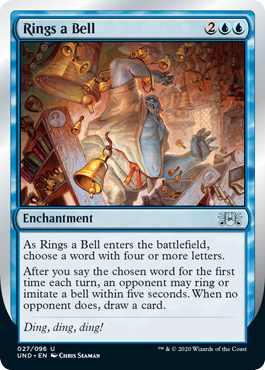
One of the tricks to making Un- cards is looking back at old designs you like and finding ways to tweak them. Rings a Bell was inspired by this card:
The game of Goblin S.W.A.T. Team is about trying to say the name of the card without your opponent cluing into the fact that you're doing it (as they have to swat the card if you do). I liked the general gameplay of Goblin S.W.A.T. Team but found that it was a little too hard to do and the payoff wasn't equal to the difficulty. Rings a Bell was an attempt at redoing the card to make it a bit more playable.
For starters, rather than being locked into a word (or a series of words in the case of Goblin S.W.A.T. Team), Rings a Bell lets you pick the word you want to use. Originally, the card let you pick any word, but after a few playtests where people chose things like "a," "the," and "um," we realized that it had to be a bit more substantial. We looked through a number of different restrictions; the four-letter cap ended up being the cleanest and most useful one. The "once a turn" restriction was kept from Goblin S.W.A.T. Team, so once you catch them (or miss them), you don't have to worry about it for the rest of the turn.
The next interesting thing about the card was what the player had to do to signify that they've caught the player saying the word. I was never super happy with the swatting of the goblin. What if the player had a bell? Like one you'd see in a hotel or a store, what's known as a call bell. I thought that was a pretty cool idea.

It's a silver-bordered card, so I thought it might be okay if the card suggested you use a bell, but I knew I had to have an answer if you didn't. I wanted it to be something clear and, ideally, humorous, so I said to imitate a bell if you didn't have one. The original text made you say, "Ding!" As we played around with the rules text, we ended up just telling you to imitate a bell but used the flavor text to reinforce that a bell dings.
Spirit of the Season
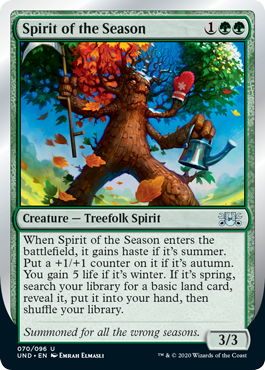
This was another "brain to print" card made by Chris Mooney. I think the only change we made was making it a Treefolk in addition to being a Spirit (Spirit of the Season was the submitted name of the card). I just wanted to walk through how Chris designed it, as there's some nuance to the design that I want to point out.
Chris wanted to make a card that had a different ability based on the season. We've made cards in the past that cared what time of day it was or whether it was day or night, but never anything that looked at the current season. The idea was that it would be a creature with a cost and stats that allowed it to get an ability, and then that ability would change by season. I think Chris chose to make the card green, as green is the color that seems like it would most care about the seasons.
My best guess is Chris chose 3/3 for 1GG as it's a strong set of stats that still has a little room for something extra. Not only did Chris want to get abilities that would play well, they also wanted them to thematically tie to the seasons as best they could. The strongest connection is the spring ability. Green can fetch basic lands, and that ties nicely into spring's flavor of rebirth. Haste was chosen for summer, as that's the time you most often run around. Life gain was chosen for winter—a period of rest during which you can't be as active. The +1/+1 counter ability was used for autumn, when the priority is to gain strength in preparation for winter.
All we did after the card was turned in was make it a Treefolk as we thought it was a graphic way to show the different seasons all on one card and add flavor text. One last thing. The reason I chose to put this card in Unsanctioned rather than save it for a potential future Un- set with a booster product was that the "play out of the box" nature of Unsanctioned increased the chance that this would be played year-round. Un- booster sets have most of their Limited play happen in one season, when the set comes out, which would have made this card mostly act in one way.
Stet, Draconic Proofreader
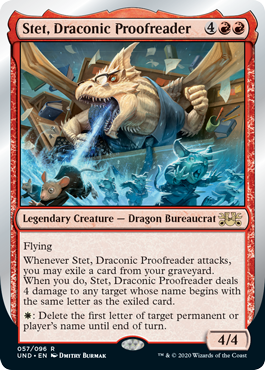
This was our red-white member of the enemy legendary creature cycle. It had to be a red card with a white activation. While trying to figure out what to make this card, I realized that we'd never made a silver-bordered Dragon, so I set out to do so. My request for the design was that I wanted a dragon that did something dragons don't normally do. What would an odd job for a dragon be? Ari Nieh was the one who suggested a proofreader.
His inspiration for making it a proofreader came from the white activation that deleted letters from the names of permanents (the original version just hit permanents, but Ari later came up with the idea of adding players, as that seemed like it could lead to some fun interactions). Stet always had a direct damage–based ability limited by the letters of the target, but Ari and I fiddled around with numerous versions to get the best execution. We liked that the final version encourages you to build a deck starting with a wide variety of different letters.
Stet's name comes from an editing term for "let it stand." It's a marking on an edited item that tells you to disregard another change being asked for. Because he was a proofreader, I went and asked the editors for a term I could use as a name, and they said Stet.
The one last thing I wanted to point out, as it may be the subtlest joke of all the jokes on the new Un- cards (and there are a number of subtle jokes—Un- cards love cramming in as many jokes as can fit), is the joke in the art. What exactly is Stet up to? He's using his frost breath to turn the mice into ice (aka removing their first letter).
Strutting | Turkey
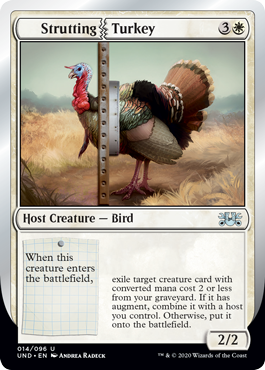
As I said two weeks ago when I talked about Bat-, I knew I wanted Unsanctioned to have a new host card and a new augment card. Strutting | Turkey is the former. Like with Bat-, I started making my new host card by listing every ability previously used on a host card:
- roll a six-sided die. You gain life equal to the result.
- you may destroy target nonland permanent.
- roll a six-sided die. Target opponent loses life equal to the result.
- you may destroy target artifact.
- you may discard a card. If you do, draw a card.
- this creature assembles a Contraption.
- target opponent discards a card.
- you may untap target permanent.
- roll a six-sided die. This creature deals damage equal to the result to target creature an opponent controls.
- create a colorless 1/1 Gnome artifact creature.
- return target host card or card with augment from your graveyard to your hand.
- you may draw a card.
- roll a six-sided die. Put a number of +1/+1 counters on this creature equal to the result.
- roll a six-sided die. Target player puts the top X cards of their library into their graveyard where X is the result.
- you may exile target non-Horse creature you control that wasn't put onto the battlefield with this ability this turn, then return it to the battlefield under its owner's control.
- creatures you control get +1/+1 until end of turn.
- target creature an opponent controls gets -1/-1 until end of turn.
- put a +1/+1 counter on target creature.
- search your library for a basic land, reveal it, put it into your hand, then shuffle your library.
Ideally, I wanted the host to be green or white as those are the two base colors of host and augment (I'd already settled in on Bat- being the augment card, which meant it was going to be in black), so I made a list of every ability that appeared in green or white that we hadn't yet done on a host. The one that seemed the most promising was the reanimation of a cheap creature. Chris had looked at my list of abilities and noted that if we used the reanimation ability limited by converted mana cost (as white normally does), it would let the player get back any of their augment cards as they technically all have a converted mana cost of 0 because they don't have mana costs. The only problem was that if you just put an augment card on the battlefield, it would immediately die because it wasn't attached to a host.
Chris worked with Gregg Luben (Unsanctioned's editor) to find a template that would allow you to get back a cheap creature or return an augment and attach it to a host. The trick ended up being to exile the card, attach it if it's an augment, and then just put it onto the battlefield if it wasn't.
We probably spent an equal amount of time trying to figure out what kind of creature this card would be. We knew it was white and didn't fly. For host creatures, we always look for creatures that have a more interesting back half as that's the part you see when it's augmented. We finally settled on a turkey.
Surgeon General Commander
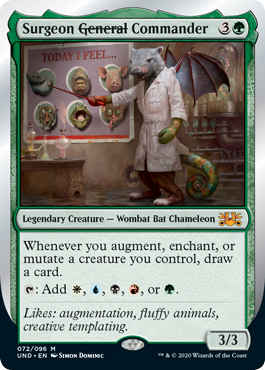
Another common ask from Unstable that we didn't deliver on was a five-color host and augment commander. The set had Dr. Julius Jumblemorph as a two-color commander (green-white), but because host and augment cards exist in all five colors, players wanted a five-color option. All the Unsanctioned cards had to exist in monocolor half-decks, so that meant I'd have to make a monocolor legendary creature that had a five-color color identity. Magic's done this before, so I knew it was possible. Host and augment were centered in green and white, so that meant this probably wanted to be one of those two colors. Being in green was a bit more flavorful (it let us make it a Crossbreed Lab creature—and yes, we forgot the watermark) and would allow more options to sneak in the five-color color identity.
I had a lot of options for promoting hosts and augments but decided to try a very blunt approach. In gameplay, one of the biggest problems of hosts and augments is card disadvantage, so allowing you to get card advantage (aka drawing a card) by playing augment cards seemed like a clean solution. The next problem to solve was that even if you played all the possible host and augment cards, you still didn't have enough cards to make a Commander deck. (There are only 34 cards total—20 hosts and 14 augments.) Was there some way to use Surgeon Commander to help broaden the deck? What is the closest to augmenting gameplaywise? Auras. Okay. What if you allowed the card to also reward the playing of auras? That would broaden the kinds of cards you could play in the deck.
What happened next was a mischievous idea. While trying to think of things that were host or augment-like, I realized we had a brand-new mechanic coming up in Ikoria: Lair of Behemoths that fit the bill, something called mutate. Unsanctioned was coming out before Ikoria, but what if I let it care about mutate? That way, when Ikoria came out, there'd be a new series of cards that you could use in the deck. And it would be a fun tease of a future mechanic, something we hadn't done before. So, I figured out who all the people were that I had to ask permission of to do this, and I asked them. All of them said yes. I'll admit, I was a bit skeptical that would happen, but was very excited when it did. So, what exactly does mutate do? Patience. Ikoria previews will start soon enough.
Next, I had to solve the problem of the five-color color identity. Basically, I needed to have all five mana symbols appear on the card somewhere. As it was a green card, the mana cost would take care of green. The obvious solution, and the one we've most often used in the past, was to give it a WUBRG activation. The problem was Unsanctioned had five half-decks where you had to shuffle any two together. There would be no combination in that format to let you play a five-color activation. I didn't mind making cards that could be better optimized out of the product, but I didn't want to make ones with parts that simply didn't work.
My next solution was to do something where the mana symbols got created rather than used as an activation. This was a green card after all, the color that can tap for any kind of mana. What if it just tapped for any color? The problem was that the template we used when you tapped for any color mana is "Add one mana of any color to your mana pool." That wouldn't give the card a five-color color identity. I ended up giving it the ability to tap for every color but green (as the mana cost covered making the card green).
The solution didn't sit right with me, though. Not letting the card tap for green weakened it quite a bit, so I changed it to tap for any color but wrote it out with the mana symbols. Yeah, this wasn't how we normally did it, but I decided to lean into it. This was a silver-bordered card after all. We could make fun of the fact that it wasn't templated correctly in order to give it a five-color color identity. I ended up using the flavor text to reinforce that the Surgeon Commander liked "creative templating."
The name came about because I realized that since this was a Commander-focused card and we were already going to make a joke about templating for Commander, we could pick a name that played into the joke. Commander was originally called Elder Dragon Highlander by the players that created it, and, back then, commanders were called generals. What if the card had a name with General which was crossed off and replaced with Commander? I looked for expressions with General in them. I liked Surgeon General because it was a well-known term (at least in the United States, it's the spokesperson in the US government for matters of public health) and we could make the card actually a surgeon. Note that when referring to the card, you can just call him Surgeon Commander. The General part isn't said because it's been crossed out.
The card was a lot of work, but I'm very happy with how it turned out.
Syr Cadian, Knight Owl
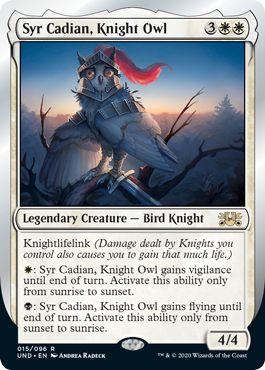
Early in the process, Max, Gaby, and I had a meeting to spitball rough ideas for new card concepts and I said that I thought it might be fun to have a white card called Knight Owl. I'd made a card called Ladies' Knight in Unhinged and thought it was time for another knight pun. Gaby took the idea and fleshed it out—it was an owl whose job was that of a knight. What exactly would an owl that's also a knight do? Gaby's original version used mechanics that we'd traditionally used on Knights, including one mechanic that cared if it was night, as owls are nocturnal. (Unstable had the card Old-Fashioned Vampire that had a bonus if it was dark out.)
When I got my hands on the card, I thought it would be cool to make this the white-black card in the enemy legendary creature cycle and have the black activated ability be the one that cared about night, as black is the color of darkness. I then realized it would be fun to have a parallel white activation that granted an ability if it was day. After looking at all the possibilities, I chose to have Syr Cadian fly at night because owls are nocturnal and must be vigilant during the day when it's easier to see all the things around you.
We needed to give it one more ability, something that would help you build around it. As it was a Knight and white-black (the two colors with the most Knights), Knight tribal seemed like a cool theme. I then started looking for expressions with "night" to find a fun mechanic name. I stumbled across "night life" and realized that I could combine it with lifelink (Knight lifelink) to grant all your Knights lifelink.
The final element of the design was the name. As it was a legendary creature, it couldn't just be Knight Owl, it needed a name. Throne of Eldraine used Syr for all its Knights, so that seemed like a good place to start. Again, I went looking for puns, and when I found Syr Cadian, I knew we had a winner. (Circadian means "recurring naturally on a 24-hour cycle.")
Underdome

In Part 1, I said the original plan for Unsanctioned was to have fifteen new designs, three in each monocolor half-deck. The product ended up having a sixteenth new design, one that showed up in all five half-decks. How did that happen? Well, the enemy legendary creature cycle happened. You see, one of the things that I knew we needed was some enemy colored Commanders as there weren't any in silver border, but Unsanctioned wasn't really designed to make that easy. The half-deck structure meant that what the product really wanted was monocolored cards. My solution was to design the enemy legendary creatures such that they were useful in a deck with just the one color but got better when you had access to the second color. But it still felt weird to have an activated ability that only got used a fourth of the time (being that there were four other half-decks to pair with).
Gavin asked me one day how I'd fix this problem. I said I'd stick in a land that could produce all five colors in each half-deck, but the only one we had was City of Ass, which involved fractions, something we'd chosen to keep out of Unsanctioned. What if I could design whatever I needed? How would I do that? Gavin said he'd find money to pay for a sixteenth piece of art. Go design a new silver-bordered land.
My parameters were pretty simple. It had to be silver bordered and had to tap for any color of mana. That's it. That's all it had to do. Surprisingly, that's a harder ask than you might think. Being silver border means that something about it can't be done in black border, and that's a tricky thing to do with lands. Chris was the one who came up with Underdome's design. We've made a handful of lands that tap for any color but whose mana could only be used for a subset of cards. Chris thought—what if that subset was just silver-bordered cards? The design was simple and compelling. I checked with Play Design to make sure it didn't have to enter the battlefield tapped, and we were good to go.
Creatively, we decided to make it represent the boxing ring you see on the cover of the box, but only after everyone had left.
It Takes Un- to Know Un-
And that, in just three short weeks, is all there is to say about the design of Unsanctioned (well, at least the design of all the new cards). If you're an Un- fan, you're in for a treat. Besides all sixteen new cards I've talked about (you get one of each except five of Underdome), the set includes 70 reprints from Unglued, Unhinged, and Unstable, most of which have never been reprinted before, ten full-art lands (two cycles worth—one foil and one non-foil), and 60 standard-frame basic lands with all-new art (twelve of each basic land type). If you've never experienced Un- cards, this may be a great way to sample an Un- product in a very replayable way.
As always, I'm eager to hear your thoughts on today's column, Unsanctioned, any of the cards I've talked about, or just Un- cards in general. You can email me or contact me through any of my social media accounts (Twitter, Tumblr, and Instagram).
Join me next week when I finally get to part two of my variance column.
Until then, may you have Un-, Un-, Un-, 'til your daddy takes the T-bird away.
#715: Unsanctioned, Part 1
#715: Unsanctioned, Part 1
49:01
This is part one of a two-part series on the design of Unsanctioned. In it, I walk through the designs of all sixteen of the new cards.
#716: Unsanctioned, Part 2
#716: Unsanctioned, Part 2
44:06
This is part two of a two-part series on the design of Unsanctioned. In it, I walk through the designs of all sixteen of the new cards.
- Episode 714 Red-Green
- Episode 713 Head-to-Head – Commander, Part 2
- Episode 712 Theros Beyond Death

